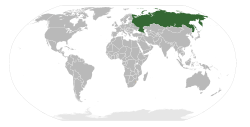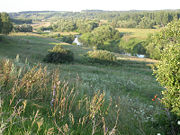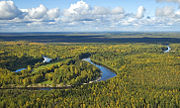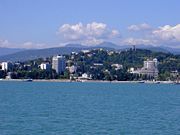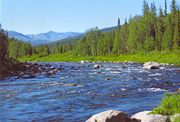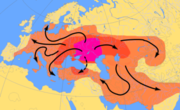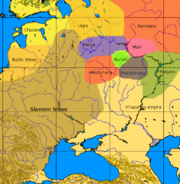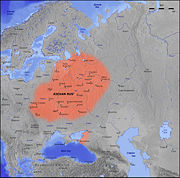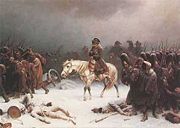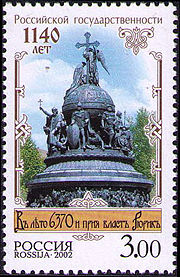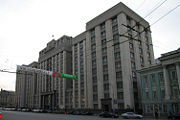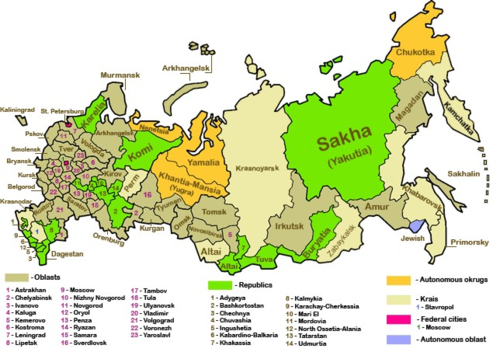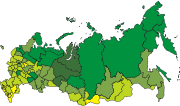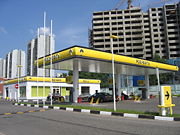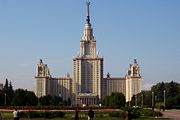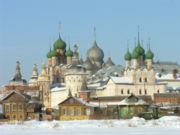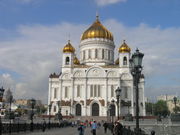Russia
2008/9 Schools Wikipedia Selection. Related subjects: Asia; Asian Countries; Europe; European Countries
| Российская Федерация Rossiyskaya Federatsiya Russian Federation
|
||||||
|---|---|---|---|---|---|---|
|
||||||
| Anthem: Государственный гимн Российской Федерации (Russian) Gosudarstvenny gimn Rossiyskoy Federatsii ( transliteration) National Anthem of the Russian Federation |
||||||
|
|
||||||
| Capital (and largest city) |
Moscow |
|||||
| Official languages | Russian official throughout nation; twenty-seven others co-official in various regions | |||||
| Demonym | Russian | |||||
| Government | Federal semi-presidential republic | |||||
| - | President | Dmitry Medvedev | ||||
| - | Prime Minister | Vladimir Putin | ||||
| Founded (862)1 | Novgorodians invited prince Rurik to keep law and order, thus giving birth to the Rurik dynasty that ruled over all Russian lands throughout more than 700 years | |||||
| Area | ||||||
| - | Total | 17,075,400 km² ( 1st) 6,592,800 sq mi |
||||
| - | Water (%) | 13 | ||||
| Population | ||||||
| - | 2008 estimate | 142,008,838 ( 9th) | ||||
| - | 2002 census | 145,166,731 | ||||
| - | Density | 8.3/km² ( 209th) 21.5/sq mi |
||||
| GDP ( PPP) | 2007 estimate | |||||
| - | Total | $2.088 trillion ( 6th) | ||||
| - | Per capita | $14,692 ( 52nd) | ||||
| GDP (nominal) | 2007 estimate | |||||
| - | Total | $1.290 trillion ( 10th) | ||||
| - | Per capita | $9,075 ( 54th) | ||||
| Gini (2005) | 40.5 | |||||
| HDI (2005) | ▲ 0.802 (high) ( 67th) | |||||
| Currency | Ruble ( RUB) |
|||||
| Time zone | ( UTC+2 to +12) | |||||
| - | Summer ( DST) | ( UTC+3 to +13) | ||||
| Internet TLD | .ru ( .su reserved), ( .рф2 proposed) | |||||
| Calling code | +7 | |||||
| 1 | The Russian Federation is the successor to earlier forms of continuous statehood, starting from 9 century AD when Rurik, a viking warrior, establishes "Russ" or "Rhos" state at Novgorod, traditionally taken as the beginning of Russian statehood | |||||
| 2 | The .рф Top-level domain has been proposed for the Russian Federation as of 2008 and will only accept domains which use the Cyrillic alphabet. | |||||
Russia (Russian: Россия, Rossiya), also the Russian Federation (Russian: Российская Федерация, Rossiyskaya Federatsiya), is a transcontinental country extending over much of northern Eurasia. It is a semi-presidential republic comprising 83 federal subjects. Russia shares land borders with the following countries (counter-clockwise from northwest to southeast): Norway, Finland, Estonia, Latvia, Lithuania ( Kaliningrad Oblast), Poland (Kaliningrad Oblast), Belarus, Ukraine, Georgia, Azerbaijan, Kazakhstan, China, Mongolia and North Korea. It is also close to the U.S. state of Alaska, Sweden, Denmark, Turkey and Japan across relatively small stretches of water (the Bering Strait, the Baltic Sea, the Black Sea and La Pérouse Strait, respectively).
At 17,075,400 square kilometers, Russia is by far the largest country in the world, covering more than an eighth of the Earth’s land area; with 142 million people, it is the ninth largest by population. It extends across the whole of northern Asia and 40% of Europe, spanning 11 time zones and incorporating a great range of environments and landforms. Russia has the world's largest mineral and energy resources, and is considered an energy superpower. It has the world's largest forest reserves and its lakes contain approximately one-quarter of the world's unfrozen fresh water.
The nation's history began with that of the East Slavs. The Slavs emerged as a recognizable group in Europe between the 3rd and 8th centuries AD. Founded and ruled by Vikings and their descendants, the first East Slavic state, Kievan Rus', arose in the 9th century and adopted Christianity from the Byzantine Empire in 988, beginning the synthesis of Byzantine and Slavic cultures that defined Russian culture for the next millennium. Kievan Rus' ultimately disintegrated and the lands were divided into many small feudal Russian states. The most powerful successor state to Kievan Rus' was Moscow, which served as the main force in the Russian reunification process and independence struggle against the Golden Horde. Moscow gradually reunified the surrounding Russian principalities and came to dominate the cultural and political legacy of Kievan Rus'. By the 18th century, the nation had greatly expanded through conquest, annexation and exploration to become the huge Russian Empire, stretching from Poland eastward to the Pacific Ocean.
Russia established worldwide power and influence from the times of the Russian Empire to being the largest and leading constituent of the Soviet Union, the world's first and largest constitutionally socialist state and a recognized superpower. The nation can boast a long tradition of excellence in every aspect of the arts and sciences. The Russian Federation was founded following the dissolution of the Soviet Union in 1991, but is recognized as the continuing legal personality of the Soviet Union. Russia is a permanent member of the United Nations Security Council and a leading member of the Commonwealth of Independent States and the G8. It is one of the five recognized nuclear weapons states and possesses the world's largest stockpile of weapons of mass destruction.
Geography
The Russian Federation stretches across much of the north of the super-continent of Eurasia. Because of its size, Russia displays both monotony and diversity. As with its topography, its climates, vegetation, and soils span vast distances. From north to south the East European Plain is clad sequentially in tundra, coniferous forest ( taiga), mixed and broad-leaf forests, grassland ( steppe), and semi-desert (fringing the Caspian Sea) as the changes in vegetation reflect the changes in climate. Siberia supports a similar sequence but is taiga. The country contains 23 World Heritage Sites and 40 UNESCO Biosphere reserves.
Topography
The two widest separated points in Russia are about 8,000 km (5,000 mi) apart along a geodesic line. These points are: the boundary with Poland on a 60 km long (40-mi long) spit of land separating the Gulf of Gdańsk from the Vistula Lagoon; and the farthest southeast of the Kuril Islands, a few miles off Hokkaidō Island, Japan. The points which are furthest separated in longitude are 6,600 km (4,100 mi) apart along a geodesic. These points are: in the West, the same spit; in the East, the Big Diomede Island (Ostrov Ratmanova). The Russian Federation spans 11 time zones.
Russia has the world's largest forest reserves and is known as "the lungs of Europe", second only to the Amazon Rainforest in the amount of carbon dioxide it absorbs. It provides a huge amount of oxygen for not just Europe, but the world. With access to three of the world's oceans—the Atlantic, Arctic, and Pacific—Russian fishing fleets are a major contributor to the world's fish supply. The Caspian is the source of what is considered the finest caviar in the world.
Most of Russia consists of vast stretches of plains that are predominantly steppe to the south and heavily forested to the north, with tundra along the northern coast. Mountain ranges are found along the southern borders, such as the Caucasus (containing Mount Elbrus, Russia's and Europe's highest point at 5,642 m / 18,511 ft) and the Altai, and in the eastern parts, such as the Verkhoyansk Range or the volcanoes on Kamchatka. The Ural Mountains form a north-south range that divides Europe and Asia, rich in mineral resources. Russia possesses 10% of the world's arable land.
Russia has an extensive coastline of over 37,000 kilometers (23,000 mi) along the Arctic and Pacific Oceans, as well as the Baltic Sea, Sea of Azov, Black and Caspian seas. The Barents Sea, White Sea, Kara Sea, Laptev Sea, East Siberian Sea, Chukchi Sea, Bering Sea, Sea of Okhotsk and the Sea of Japan are linked to Russia. Major islands and archipelagos include Novaya Zemlya, the Franz Josef Land, the Severnaya Zemlya, the New Siberian Islands, Wrangel Island, the Kuril Islands and Sakhalin. The Diomede Islands (one controlled by Russia, the other by the United States) are just three kilometers (1.9 mi) apart, and Kunashir Island is about twenty kilometers (12 mi) from Hokkaidō.
Russia has thousands of rivers and inland bodies of water, providing it with one of the world's largest surface water resources. The most prominent of Russia's bodies of fresh water is Lake Baikal, the world's deepest, purest and most capacious freshwater lake. Lake Baikal alone contains over one fifth of the world's fresh surface water. Of its 100,000 rivers, The Volga is the most famous—not only because it is the longest river in Europe but also because of its major role in Russian history. Major lakes include Lake Baikal, Lake Ladoga and Lake Onega. Russia has a wide natural resource base unmatched by any other country, including major deposits of petroleum, natural gas, coal, timber and mineral resources.
Climate
The climate of the Russian Federation formed under the influence of several determining factors. The enormous size of the country and the remoteness of many areas from the sea result in the dominance of the continental climate, which is prevalent in European and Asian Russia except for the tundra and the extreme southeast. Mountains in the south obstructing the flow of warm air masses from the Indian Ocean and the plain of the west and north makes the country open to Arctic and Atlantic influences.
Throughout much of the territory there are only two distinct seasons — winter and summer; spring and autumn are usually brief periods of change between extremely low temperatures and extremely high. The coldest month is January (on the shores of the sea—February), the warmest usually is July. Great ranges of temperature are typical. In winter, temperatures get colder both from south to north and from west to east. Summers can be quite hot and humid, even in Siberia. A small part of Black Sea coast around Sochi is considered in Russia to have subtropical climate. The continental interiors are the driest areas.
History
Early periods
In prehistoric times, the vast steppes of Southern Russia were home to disunited tribes of nomadic pastoralists. In classical antiquity, the Pontic Steppe was known as Scythia. Remnants of these steppe civilizations were discovered in the course of the 20th century in such places as Ipatovo, Sintashta, Arkaim, and Pazyryk. In the latter part of the eighth century BC, Greek traders brought classical civilization to the trade emporiums in Tanais and Phanagoria. Between the third and sixth centuries BC, the Bosporan Kingdom, a Hellenistic polity which succeeded the Greek colonies, was overwhelmed by successive waves of nomadic invasions, led by warlike tribes, such as the Huns and Turkic Avars. A Turkic people, the Khazars, ruled the lower Volga basin steppes between the Caspian and Black Seas until the 8th century.
The ancestors of modern Russians are the Slavic tribes, whose original home is thought by some scholars to have been the wooded areas of the Pinsk Marshes. Moving into the lands vacated by the migrating Germanic tribes, the Early East Slavs gradually settled Western Russia in two waves: one moving from Kiev toward present-day Suzdal and Murom and another from Polotsk toward Novgorod and Rostov. From the 7th century onwards, the East Slavs constituted the bulk of the population in Western Russia and slowly but peacefully assimilated the native Finno-Ugric tribes, including the Merya, the Muromians, and the Meshchera.
Kievan Rus
Scandinavian Norsemen, called "Vikings" in Western Europe and " Varangians" in the East, combined piracy and trade in their roamings over much of Northern Europe. In the mid-9th century, they ventured along the waterways extending from the eastern Baltic to the Black and Caspian Seas. According to the earliest Russian chronicle, a Varangian named Rurik was elected ruler ( konung or knyaz) of Novgorod around the year 860; his successors moved south and extended their authority to Kiev, which had been previously dominated by the Khazars.
In the 10th to 11th centuries this state of Kievan Rus' became the largest and most prosperous in Europe. The reigns of Vladimir the Great (980-1015) and his son Yaroslav I the Wise (1019-1054) constitute the Golden Age of Kiev, which saw the acceptance of Orthodox Christianity and the creation of the first East Slavic written legal code, the Russkaya Pravda.
In the 11th and 12th centuries, constant incursions by nomadic Turkic tribes, such as the Kipchaks and the Pechenegs, caused a massive migration of Slavic populations to the safer, heavily forested regions of the north, particularly to the area known as Zalesye. Like many other parts of Eurasia, these territories were overrun by the Mongols. The invaders, later known as Tatars, formed the state of the Golden Horde, which pillaged the Russian principalities and ruled the southern and central expanses of Russia for over three centuries. Mongol rule retarded the country's economic and social development. However, the Novgorod Republic together with Pskov retained some degree of autonomy during the time of the Mongol yoke and was largely spared the atrocities that affected the rest of the country. Led by Alexander Nevsky, Novgorodians repelled the Germanic crusaders who attempted to colonize the region. Kievan Rus' ultimately disintegrated as a state because of in-fighting between members of the princely family that ruled it collectively. Kiev's dominance waned, to the benefit of Vladimir-Suzdal in the north-east, Novgorod in the north-west, and Galicia-Volhynia in the south-west. Conquest by the Golden Horde in the 13th century was the final blow and resulted in the destruction of Kiev in 1240. Galicia-Volhynia was eventually absorbed into the Polish-Lithuanian Commonwealth, while the Mongol-dominated Vladimir-Suzdal and the independent Novgorod Republic, two regions on the periphery of Kiev, established the basis for the modern Russian nation.
Grand Duchy of Moscow and Tsardom of Russia
The most powerful successor state to Kievan Rus' was Grand Duchy of Moscow. It would annex rivals such as Tver and Novgorod, and eventually become the basis of the modern Russian state. After the fall of Constantinople in 1453, Moscow claimed succession to the legacy of the Eastern Roman Empire. While still under the domain of the Mongol-Tatars and with their connivance, the Duchy of Moscow (or "Muscovy") began to assert its influence in Western Russia in the early 14th century. Assisted by the Russian Orthodox Church and Saint Sergius of Radonezh's spiritual revival, Russia inflicted a defeat on the Mongol-Tatars in the Battle of Kulikovo (1380). Ivan III (Ivan the Great) eventually threw off the control of the invaders, consolidated surrounding areas under Moscow's dominion and was the first to take the title "grand duke of all the Russias".
In 1547, Ivan IV (Ivan the Terrible) was officially crowned the first Tsar of Russia. During his long reign, Ivan IV annexed the Tatar khanates ( Kazan, Astrakhan) along the Volga River and transformed Russia into a multiethnic and multiconfessional state. Ivan IV promulgated a new code of laws ( Sudebnik of 1550), established the first Russian feudal representative body ( Zemsky Sobor) and introduced local self-management into the rural regions. But Ivan IV's rule was also marked by the long and unsuccessful Livonian War against the coalition of Poland, Lithuania, and Sweden for access to the Baltic coast and sea trade. The military losses, epidemics and poor harvests weakened the state, and the Crimean Tatars were able to burn down Moscow. The death of Ivan's sons, combined with famine (1601–1603), led to the civil war and foreign intervention of the Time of Troubles in the early 1600s. By the mid-17th century there were Russian settlements in Eastern Siberia, on the Chukchi Peninsula, along the Amur River, and on the Pacific coast. The Bering Strait between North America and Asia was first sighted by a Russian explorer in 1648.
Imperial Russia
Under the Romanov dynasty and Peter I (Peter the Great), the Russian Empire became a world power. Ruling from 1682 to 1725, Peter defeated Sweden in the Great Northern War, forcing it to cede West Karelia and Ingria (two regions lost by Russia in the Time of Troubles), Estland, and Livland, securing Russia's access to the sea and sea trade. It was in Ingria that Peter founded a new capital, Saint Petersburg. Peter's reforms brought considerable Western European cultural influences to Russia. Catherine II (Catherine the Great), who ruled from 1762 to 1796, continued the efforts to establish Russia as one of the Great Powers of Europe. In alliance with Prussia and Austria, Russia stood against Napoleon's France and eliminated its rival Poland-Lithuania in a series of partitions, gaining large areas of territory in the west. As a result of its victories in the Russo-Turkish War, by the early 19th century Russia had made significant territorial gains in Transcaucasia. Napoleon's invasion failed miserably as obstinate Russian resistance combined with the bitterly cold Russian winter dealt him a disastrous defeat, in which more than 95% of his invading force perished. The officers in the Napoleonic Wars brought ideas of liberalism back to Russia with them and even attempted to curtail the tsar's powers during the abortive Decembrist revolt of 1825, which was followed by several decades of political repression.

The prevalence of serfdom and the conservative policies of Nicolas I impeded the development of Russia in the mid-nineteenth century. Nicholas's successor Alexander II (1855–1881) enacted significant reforms, including the abolition of serfdom in 1861; these "Great Reforms" spurred industrialization. However, many socio-economic conflicts were aggravated during Alexander III’s reign and under his son, Nicholas II. Harsh conditions in factories created mass support for the revolutionary socialist movement. In January 1905, striking workers peaceably demonstrated for reforms in Saint Petersburg but were fired upon by troops, killing and wounding hundreds. The abject failure of the Tsar's military forces in the initially-popular Russo-Japanese War, and the event known as " Bloody Sunday", ignited the Russian Revolution of 1905. Although the uprising was swiftly put down by the army and although Nicholas II retained much of his power, he was forced to concede major reforms, including granting the freedoms of speech and assembly, the legalization of political parties and the creation of an elected legislative assembly, the Duma; however, the hopes for basic improvements in the lives of industrial workers were unfulfilled.
Russia entered World War I in aid of its ally Serbia and fought a war across three fronts while isolated from its allies. Russia did not want war but felt that the only alternative was German domination of Europe. Although the army was far from defeated in 1916, the already-existing public distrust of the regime was deepened by the rising costs of war, casualties (Russia suffered the highest number of both military and civilian deaths of the Entente Powers), and tales of corruption and even treason in high places, leading to the outbreak of the Russian Revolution of 1917. A series of uprisings were organized by workers and peasants throughout the country, as well as by soldiers in the Russian army, who were mainly of peasant origin. Many of the uprisings were organized and led by democratically-elected councils called Soviets. The February Revolution overthrew the Russian monarchy, which was replaced by a shaky coalition of political parties that declared itself the Provisional Government. The abdication marked the end of imperial rule in Russia, and Nicholas and his family were imprisoned and later executed during the Civil War. While initially receiving the support of the Soviets, the Provisional Government proved unable to resolve many problems which had led to the February Revolution. The second revolution, the October Revolution, led by Vladimir Lenin, overthrew the Provisional Government and created the world’s first Communist state.
Soviet Russia
Following the October Revolution, a civil war broke out between the new regime and the Socialist Revolutionaries, Mensheviks, and the White movement. The Treaty of Brest-Litovsk concluded hostilities with the Central Powers in World War I. Russia lost its Ukrainian, Polish and Baltic territories, and Finland by signing the treaty. The Allied powers launched a military intervention in support of anti-Communist forces and both the Bolsheviks and White movement carried out campaigns of deportations and executions against each other, known respectively as the Red Terror and White Terror. By the end of the Civil War, some 20 million had died and the Russian economy and infrastructure were completely devastated. Following victory in the Civil War, the Russian SFSR together with three other Soviet republics formed the Soviet Union on December 30, 1922. The Russian Soviet Federative Socialist Republic dominated the Soviet Union for its entire 74-year history; the USSR was often referred to as "Russia" and its people as "Russians." The largest of the republics, Russia contributed over half the population of the Soviet Union. The Bolsheviks introduced free universal health care, education and social-security benefits, as well as the right to work and housing. Women's rights were greatly increased through new laws aimed to wipe away centuries-old inequalities. Notably, Russia became the first country in the world with full freedom of divorce and legalized abortion. After Lenin's death in 1924 Joseph Stalin consolidated power and became dictator. Stalin launched a command economy, rapid industrialization of the largely rural country and collectivization of its agriculture and the Soviet Union was transformed from an agrarian economy to a major industrial powerhouse in a short span of time.

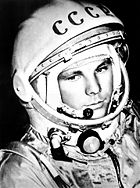
On June 22, 1941, Nazi Germany invaded the Soviet Union with the largest and most powerful invasion force in human history, opening the largest theatre of the Second World War. Although the German army had considerable success early on, they suffered defeats after reaching the outskirts of Moscow and were dealt their first major defeat at the Battle of Stalingrad in the winter of 1942–1943. Soviet forces drove through Eastern Europe in 1944–45 and captured Berlin in May, 1945. In the conflict, Soviet military and civilian death toll were 10.6 million and 15.9 million respectively, accounting for half of all World War II casualties. The Soviet economy and infrastructure suffered massive devastation but the Soviet Union emerged as an acknowledged superpower. The Red Army occupied Eastern Europe after the war, including the eastern half of Germany; Stalin installed communist governments in these satellite states. Becoming the world's second nuclear weapons power, the USSR established the Warsaw Pact alliance and entered into a struggle for global dominance with the United States, which became known as the Cold War.
Under Stalin's successor Nikita Khrushchev, the Soviet Union launched the world's first artificial satellite, Sputnik 1 and the Russian cosmonaut Yuri Gagarin became the first human being to orbit the Earth aboard the first manned spacecraft, Vostok 1. Tensions with the United States heightened when the two rivals clashed over the deployment of the U.S. Jupiter missiles in Turkey and Soviet missiles in Cuba. Following the ousting of Khrushchev, another period of rule by collective leadership ensued until Leonid Brezhnev established himself in the early 1970s as the pre-eminent figure in Soviet politics. Brezhnev's rule oversaw economic stagnation and the Soviet invasion of Afghanistan, which dragged on without success and with continuing casualties inflicted by insurgents. Soviet citizens became increasingly discontented with the war, ultimately leading to the withdrawal of Soviet forces by 1989.
From 1985 onwards, Mikhail Gorbachev introduced the policies of glasnost (openness) and perestroika (restructuring) in an attempt to modernize the country. The USSR economy was the second largest in the world prior to the Soviet collapse. During its last years, the economy was afflicted by shortages of goods in grocery stores, huge budget deficits and explosive growth in money supply leading to inflation. In August 1991, an unsuccessful military coup against Gorbachev aimed at preserving the Soviet Union instead led to its collapse. In Russia, Boris Yeltsin came to power and declared the end of Communist rule. The USSR splintered into fifteen independent republics and was officially dissolved in December 1991. Boris Yeltsin was elected the President of Russia in June 1991, in the first direct presidential election in Russian history.
Russian Federation
During and after the disintegration of the USSR when wide ranging reforms including privatisation and market and trade liberalization were being undertaken, the Russian economy went through a major crisis. This period was characterized by deep contraction of output, with GDP declining by roughly 50 percent between 1990 and the end of 1995 and industrial output declining by over 50 percent. In October 1991, Yeltsin announced that Russia would proceed with radical, market-oriented reform along the lines of " shock therapy", as recommended by the United States and International Monetary Fund. Price controls were abolished, privatization was started. Millions were plunged into poverty. According to the World Bank, whereas 1.5% of the population was living in poverty in the late Soviet era, by mid-1993 between 39% and 49% of the population was living in poverty. Delays in wage payment became a chronic problem with millions being paid months, even years late. Russia took up the responsibility for settling the USSR's external debts, even though its population made up just half of the population of the USSR at the time of its dissolution. The privatization process largely shifted control of enterprises from state agencies to groups of individuals with inside connections in the Government and the mafia. Violent criminal groups often took over state enterprises, clearing the way through assassinations or extortion. Corruption of government officials became an everyday rule of life. Many of the newly rich mobsters and businesspeople took billions in cash and assets outside of the country in an enormous capital flight. The long and wrenching depression was coupled with social decay. Social services collapsed and the birth rate plummeted while the death rate skyrocketed. The early and mid-1990s was marked by extreme lawlessness. Criminal gangs and organized crime flourished and murders and other violent crime spiraled out of control.
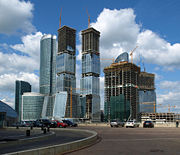
In 1993 a constitutional crisis resulted in the worst civil strife in Moscow since the October Revolution. President Boris Yeltsin illegally dissolved the country's legislature which opposed his moves to consolidate power and push forward with unpopular neo-liberal reforms; in response, legislators barricaded themselves inside the White House, impeached Yeltsin and elected a new President and major protests against Yeltsin's government resulted in hundreds killed. With military support, Yeltsin sent the army to besiege the parliament building and disperse its defenders and used tanks and artillery to eject the legislators.
The 1990s were plagued by armed ethnic conflicts in the North Caucasus. Such conflicts took a form of separatist Islamist insurrections against federal power (most notably in Chechnya), or of ethnic/clan conflicts between local groups (e.g., in North Ossetia-Alania between Ossetians and Ingushs, or between different clans in Chechnya). Since the Chechen separatists declared independence in the early 1990s, an intermittent guerrilla war ( First Chechen War, Second Chechen War) has been fought between disparate Chechen rebel groups and the Russian military. Terrorist attacks against civilians carried out by Chechen separatists, most notably the Moscow theatre hostage crisis and Beslan school siege, caused hundreds of deaths and drew worldwide attention. High budget deficits and the 1997 Asian Financial Crisis caused the financial crisis of 1998 and resulted in further GDP decline. On December 31, 1999 Boris Yeltsin resigned from the presidency, handing the post to the recently appointed prime minister, Vladimir Putin, who then won the 2000 election. Putin won popularity for suppressing the Chechen insurgency, although sporadic violence still occurs throughout the North Caucasus. High oil prices and initially weak currency followed by increasing domestic demand, consumption and investments has helped the economy grow for nine straight years, alleviating the standard of living and increasing Russia's clout on the world stage. While many reforms made under Putin’s rule have been generally criticized by Western nations as un-democratic, Putin's leadership over the return of order, stability and progress has won him widespread popularity in Russia, as well as recognition abroad.
Government and politics
According to the Constitution, which was adopted by national referendum on December 12, 1993 following the 1993 Russian constitutional crisis, Russia is a federation and a semi-presidential republic, wherein the President is the head of state and the Prime Minister is the head of government. The Russian Federation is fundamentally structured as a representative democracy. Executive power is exercised by the government. Legislative power is vested in both the government and the two chambers of the Federal Assembly. The government is regulated by a system of checks and balances defined by the Constitution of the Russian Federation, which serves as the country's supreme legal document and as a social contract for the people of the Russian Federation.
The federal government is composed of three branches:
- Legislative: The bicameral Federal Assembly, made up of the State Duma and the Federation Council makes federal law, declares war, approves treaties, has the power of the purse, and has power of impeachment, by which it can remove sitting members of the government.
- Executive: The president is the commander-in-chief of the military, can veto legislative bills before they become law, and appoints the Cabinet and other officers, who administer and enforce federal laws and policies.
- Judiciary: The Constitutional Court, Supreme Court, Supreme Court of Arbitration and lower federal courts, whose judges are appointed by the Federation Council on the recommendation of the president, interpret laws and can overturn laws they deem unconstitutional.
According to the Constitution of Russia, constitutional justice in the court is based on the equality of all citizens, judges are independent and subject only to the law, trials are to be open and the accused is guaranteed a defense. Since 1996, Russia has instituted a moratorium on the death penalty in Russia, although capital punishment has not been abolished by law.
The president is elected by popular vote for a four-year term (eligible for a second term but constitutionally barred for a third consecutive term); election last held 2 March 2008. Ministries of the government are composed of the premier and his deputies, ministers, and selected other individuals; all are appointed by the president. The national legislature is the Federal Assembly, which consists of two chambers; the 450-member State Duma and the 176-member Federation Council. Leading political parties in Russia include United Russia, the Communist Party, the Liberal Democratic Party of Russia and Fair Russia.
Subdivisions
- Federal subjects
The Russian Federation comprises 83 federal subjects. These subjects have equal representation—two delegates each—in the Federation Council. However, they differ in the degree of autonomy they enjoy.
- 46 oblasts (provinces): most common type of federal subjects, with federally appointed governor and locally elected legislature.
- 21 republics: nominally autonomous; each has its own constitution, president, and parliament. Republics are allowed to establish their own official language alongside Russian but are represented by the federal government in international affairs. Republics are meant to be home to specific ethnic minorities.
- Nine krais (territories): essentially the same as oblasts. The "territory" designation is historic, originally given to frontier regions and later also to administrative divisions that comprised autonomous okrugs or autonomous oblasts.
- Four autonomous okrugs (autonomous districts): originally autonomous entities within oblasts and krais created for ethnic minorities, their status was elevated to that of federal subjects in the 1990s. With the exception of Chukotka Autonomous Okrug, all autonomous okrugs are still administratively subordinated to a krai or an oblast of which they are a part.
- One autonomous oblast (the Jewish Autonomous Oblast): originally autonomous oblasts were administrative units subordinated to krais. In 1990, all of them except the Jewish AO were elevated in status to that of a republic.
- Two federal cities (Moscow and St. Petersburg): major cities that function as separate regions.
- Federal districts and economic regions
Federal subjects are grouped into seven federal districts, each administered by an envoy appointed by the President of Russia. Unlike the federal subjects, the federal districts are not a subnational level of government, but are a level of administration of the federal government. Federal districts' envoys serve as liaisons between the federal subjects and the federal government and are primarily responsible for overseeing the compliance of the federal subjects with the federal laws.
Foreign relations and military
The Russian Federation is recognized in international law as continuing the legal personality of the former Soviet Union. Russia continues to implement the international commitments of the USSR, and has assumed the USSR's permanent seat on the UN Security Council, membership in other international organizations, the rights and obligations under international treaties and property and debts. Russia has a multifaceted foreign policy. It maintains diplomatic relations with 178 countries and has 140 embassies. Russia's foreign policy is determined by the President and implemented by the Ministry of Foreign Affairs.
As one of five permanent members of the UN Security Council, Russia plays a major role in maintaining international peace and security, and plays a major role in resolving international conflicts by participating in the Quartet on the Middle East, the Six-party talks with North Korea, promoting the resolution of the Kosovo conflict and resolving nuclear proliferation issues. Russia is a member of the Group of Eight (G8) industrialized nations, the Council of Europe, OSCE and APEC. Russia usually takes a leading role in regional organizations such as the CIS, EurAsEC, CSTO, and the SCO. Former President Vladimir Putin had advocated a strategic partnership with close integration in various dimensions including establishment of four common spaces between Russia and the EU. Since the collapse of the Soviet Union, Russia has developed a friendlier, albeit volatile relationship with NATO. The NATO-Russia Council was established in 2002 to allow the 26 Allies and Russia to work together as equal partners to pursue opportunities for joint collaboration.
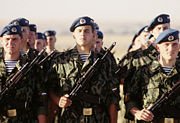
Russia assumed control of Soviet assets abroad and most of the Soviet Union's production facilities and defense industries are located in the country. The Russian military is divided into the Ground Forces, Navy, and Air Force. There are also three independent arms of service: Strategic Rocket Forces, Military Space Forces, and the Airborne Troops. In 2006, the military had 1.037 million personnel on active duty. Russia has the largest stockpile of nuclear weapons in the world. It has the second largest fleet of ballistic missile submarines and is the only country apart from the U.S. with a modern strategic bomber force. The country has a large and fully indigenous arms industry, producing all of its own military equipment. Russia is the world's top supplier of weapons, a spot it has held since 2001, accounting for around 30% of worldwide weapons sales and exporting weapons to about 80 countries. Following the Soviet practice, it is mandatory for all male citizens aged 18–27 to be drafted for two years' Armed Forces service, though various problems associated with this is why the armed forces are from 2008 reducing the conscription term from 18 months to 12, and plan to increase contract servicemen to compose 70% of the armed forces by 2010. Defense expenditure has quadrupled over the past six years. Official government military spending for 2008 is $40 billion, though various sources, including US intelligence, and the International Institute for Strategic Studies, have estimated Russia’s military expenditures to be considerably higher. Currently, the military is undergoing a major equipment upgrade with about $200 billion on procurement of military equipment between 2006 and 2015.
Economy
Since the turn of the century, rising oil prices, increased foreign investment, higher domestic consumption and greater political stability have bolstered economic growth in Russia. The country ended 2007 with its ninth straight year of growth, averaging 7% annually since the financial crisis of 1998. In 2007, Russia's GDP was $2.076 trillion (est. PPP), the 7th largest in the world, with GDP growing 8.1% from the previous year. Growth was primarily driven by non-traded services and goods for the domestic market, as opposed to oil or mineral extraction and exports. The average salary in Russia was $640 per month in early 2008, up from $80 in 2000. Approximately 14% of Russians lived below the national poverty line in 2007, significantly down from 40% in 1998 at the worst of the post-Soviet collapse. Unemployment in Russia was at 6% in 2007, down from about 12.4% in 1999.
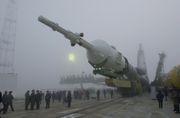
Russia has the world's largest natural gas reserves, the second largest coal reserves and the eighth largest oil reserves. It is the world's leading natural gas exporter and the second leading oil exporter. Oil, natural gas, metals, and timber account for more than 80% of Russian exports abroad. Since 2003, however, exports of natural resources started decreasing in economic importance as the internal market strengthened considerably. Despite higher energy prices, oil and gas only contribute to 5.7% of Russia's GDP and the government predicts this will drop to 3.7% by 2011. Russia is also considered well ahead of most other resource-rich countries in its economic development, with a long tradition of education, science, and industry. The country has more higher education graduates than any other country in Europe.
A simpler, more streamlined tax code adopted in 2001 reduced the tax burden on people, and dramatically increased state revenue. Russia has a flat personal income tax rate of 13 percent. This ranks it as the country with the second most attractive personal tax system for single managers in the world after the United Arab Emirates, according to a 2007 survey by investment services firm Mercer Human Resource Consulting. The federal budget has run surpluses since 2001 and ended 2007 with a surplus of 6% of GDP. Over the past several years, Russia has used oil revenues from its Stabilization Fund of the Russian Federation to prepay all Soviet-era sovereign debt to Paris Club creditors and the IMF. Oil export earnings have allowed Russia to increase its foreign reserves from $12 billion in 1999 to some $470 billion at the end of 2007, the third largest reserves in the world. The country has also been able to substantially reduce its formerly massive foreign debt.
The economic development of the country though has been uneven geographically with the Moscow region contributing a disproportionately high amount of the country's GDP. Much of Russia, especially indigenous and rural communities in Siberia, lags significantly behind. Nevertheless, the middle class has grown from just 8 million persons in 2000 to 55 million persons in 2006. Russia is home to the largest number of billionaires in the world after the United States, gaining 50 billionaires in 2007 for a total of 110.
Over the last five years, fixed capital investments have averaged real gains greater than 10% per year and personal incomes have achieved real gains more than 12% per year. During this time, poverty has declined steadily and the middle class has continued to expand. Russia has also improved its international financial position since the 1998 financial crisis. A principal factor in Russia's growth has been the combination of strong growth in productivity, real wages, and consumption. Despite the country's strong economic performance since 1999, however, the World Bank lists several challenges facing the Russian economy including diversifying the economy, encouraging the growth of small and medium enterprises, building human capital and improving corporate governance. Inflation grew to about 12% by the end of 2007, up from 9% in 2006. The upward trend continued in the first quarter of 2008, driven largely by rising food costs.
Demographics
| Ethnic composition (2002) | |
|---|---|
| Russians | 79.8% |
| Tatars | 3.8% |
| Ukrainians | 2.0% |
| Chuvash | 1.1% |
| Chechen | 0.9% |
| Armenians | 0.8% |
| Other/unspecified | 10.3% |
According to preliminary estimates, the resident population of the Russian Federation on 1 January 2008 was 142 million people. In 2007, the population shrank by 237,800 people, or by 0.17% (in 2006 - by 532,600 people, or by 0.37%). Migration grew by 50.2% in 2007 to reach 274,000. The vast majority of migrants came from CIS states and were Russians or Russian-speaking. The Russian Federation is a diverse, multi-ethnic society, home to as many as 160 different ethnic groups and indigenous peoples. Though Russia's population is comparatively large, its population density is low because of the country's enormous size. Population is densest in European Russia, near the Ural Mountains, and in the southwest Siberia.
73% of the population lives in urban areas. As of the 2002 Census, the two largest cities in Russia are Moscow (10,126,424 inhabitants) and Saint Petersburg (4,661,219). Eleven other cities have between one and two million inhabitants: Chelyabinsk, Kazan, Novosibirsk, Nizhny Novgorod, Omsk, Perm, Rostov-on-Don, Samara, Ufa, Volgograd, and Yekaterinburg. In 2006, 186,380 migrants arrived to the Russian Federation of which 95% came from CIS countries. There are also an estimated 10 million illegal immigrants from the ex-Soviet states in Russia.
Russia's population peaked in 1991 at 148,689,000. The number of deaths during 2007 was 477,700 greater than the number of births. This is down from 687,100 in 2006. According to data published by the Russian Federal State Statistics Service, the mortality rate in Russia declined 4% in 2007, as compared to 2006, reaching some 2 million deaths, while the birth rate grew 8.3% year-on-year to an estimated 1.6 million live births. The primary causes of Russia's population decrease are a high death rate and low birth rate. While Russia's birth-rate is comparable to that of other European countries (11.3 births per 1000 people in 2007 compared to the European Union average of 10.00 per 1000) its population declines at much greater rate due to a substantially higher death rate (In 2007, Russia's death rate was 14.7 per 1000 people compared to the European Union average of 10.00 per 1000). However, the Russian health ministry predicts that by 2011, the death rate will equal the birth rate due to increases in fertility and decline in mortality.
| Rank | Core City | Federal Subject | Pop. | Rank | Core City | Federal Subject | Pop. | |||
|---|---|---|---|---|---|---|---|---|---|---|
| 1 | Moscow | Moscow | 10,126,424 | 11 | Ufa | Bashkortostan | 1,042,437 | |||
| 2 | Saint Petersburg | Saint Petersburg | 4,661,219 | 12 | Volgograd | Volgograd | 1,011,417 | |||
| 3 | Novosibirsk | Novosibirsk | 1,425,508 | 13 | Perm | Perm | 1,001,653 | |||
| 4 | Nizhny Novgorod | Nizhny Novgorod | 1,311,252 | 14 | Krasnoyarsk | Krasnoyarsk | 909,341 | |||
| 5 | Yekaterinburg | Sverdlovsk | 1,293,537 | 15 | Saratov | Saratov | 873,055 | |||
| 6 | Samara | Samara | 1,157,880 | 16 | Voronezh | Voronezh | 848,752 | |||
| 7 | Omsk | Omsk | 1,134,016 | 17 | Tolyatti | Samara | 702,879 | |||
| 8 | Kazan | Tatarstan | 1,105,289 | 18 | Krasnodar | Krasnodar | 646,175 | |||
| 9 | Chelyabinsk | Chelyabinsk | 1,077,174 | 19 | Ulyanovsk | Ulyanovsk | 635,947 | |||
| 10 | Rostov-on-Don | Rostov | 1,068,267 | 20 | Izhevsk | Udmurtia | 632,140 | |||
| 2002 Census | ||||||||||
Education
Russia has a free education system guaranteed to all citizens by the Constitution, and has a literacy rate of 99.4%. The country came first in the world in the 2006 Progress in International Reading Literacy Study conducted by Boston College. Entry to higher education is highly competitive. As a result of great emphasis on science and technology in education, Russian medical, mathematical, scientific, and space and aviation research is still generally of a high order.
The Russian Constitution grants a universal right to higher education free of charge through competitive entry. The Government allocates funding to pay the tuition fees within an established quota, or number of students for each state institution. This is considered crucial because it provides access to higher education to all skilled students, as opposed to only those who can afford it. In addition, students are paid a small stipend and provided with free housing. However, the institutions have to be funded entirely from the federal and regional budgets; institutions have found themselves unable to provide adequate teachers' salaries, students' stipends, and to maintain their facilities. To address the issue, many state institutions started to open commercial positions, which have been growing steadily since. Many private higher education institutions have emerged to address the need for a skilled work-force for high-tech and emerging industries and economic sectors.
Health
Russia's constitution guarantees free, universal health care for all citizens. While Russia has more physicians, hospitals, and health care workers than almost any other country in the world, since the collapse of the Soviet Union the health of the Russian population has declined considerably as a result of social, economic, and lifestyle changes. As of 2007, the average life expectancy in Russia is 61.5 years for males and 73.9 years for females. The average Russian life expectancy of 67.7 years at birth is 10.8 years shorter than the overall figure in the European Union. The biggest factor contributing to this relatively low life expectancy for males is a high mortality rate among working-age males from preventable causes (e.g., alcohol poisoning, stress, smoking, traffic accidents, violent crimes). Mortality among Russian men rose by 60% since 1991, four to five times higher than in Europe. As a result of the large difference in life expectancy between men and women and because of the lasting effect of World War II, where Russia lost more men than any other nation in the world, the gender imbalance remains to this day and there are 0.859 males to every female.
Heart diseases account for 56.7% of total deaths, with about 30% involving people still of working age. About 16 million Russians suffer from cardiovascular diseases, placing Russia second in the world, after Ukraine, in this respect. Death rates from homicide, suicide and cancer are also especially high. According to a 2007 survey by Romir Monitoring, 52% of men and 15% of women smoke. More than 260,000 lives are lost each year as a result of tobacco use. HIV/AIDS, virtually non-existent in the Soviet era, rapidly spread following the collapse, mainly through the explosive growth of intravenous drug use. According to official statistics, there are currently more than 364,000 people in Russia registered with HIV, but independent experts place the number significantly higher. In increasing efforts to combat the disease, the government increased spending on HIV control measures 20-fold in 2006, and the 2007 budget doubled that of 2006. Since the Soviet collapse, there has also been a dramatic rise in both cases of and deaths from tuberculosis, with the disease being particularly widespread amongst prison inmates.
In an effort to stem Russia’s demographic crisis, the government is implementing a number of programs designed to increase the birth rate and attract more migrants to alleviate the problem. The government has doubled monthly child support payments and offered a one-time payment of 250,000 Rubles (around US$10,000) to women who had a second child since 2007. In 2007, Russia saw the highest birth rate since the collapse of the USSR. The First Deputy PM also said about 20 billion rubles (about US$1 billion) will be invested in new prenatal centres in Russia in 2008–2009. Immigration is increasingly seen as necessary to sustain the country's population.
Language
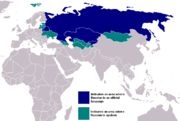
Russia's 160 ethnic groups speak some 100 languages. According to the 2002 census, 142.6 million people speak Russian, followed by Tatar with 5.3 million and German with 2.9 million speakers. Russian is the only official state language, but the Constitution gives the individual republics the right to make their native language co-official next to Russian. Despite its wide dispersal, the Russian language is homogeneous throughout Russia. Russian is the most geographically widespread language of Eurasia and the most widely spoken Slavic language. Russian belongs to the Indo-European language family and is one of three (or, according to some authorities, four) living members of the East Slavic languages; the others being Belarusian and Ukrainian (and possibly Rusyn). Written examples of Old East Slavic (Old Russian) are attested from the 10th century onwards.
Over a quarter of the world's scientific literature is published in Russian. Russian is also applied as a means of coding and storage of universal knowledge—60–70% of all world information is published in English and Russian languages. The language is one of the six official languages of the United Nations.
Religion
Christianity, Islam, Buddhism, and Judaism are Russia’s traditional religions, deemed part of Russia's "historical heritage" in a law passed in 1997. Estimates of believers widely fluctuate among sources, and some reports put the number of non-believers in Russia as high as 16–48% of the population. Russian Orthodoxy is the dominant religion in Russia. 95% of the registered Orthodox parishes belong to the Russian Orthodox Church while there are a number of smaller Orthodox Churches. However, the vast majority of Orthodox believers do not attend church on a regular basis. Nonetheless, the church is widely respected by both believers and nonbelievers, who see it as a symbol of Russian heritage and culture. Smaller Christian denominations such as Roman Catholics, Armenian Gregorian and various Protestants exist.
The ancestors of many of today’s Russians adopted Orthodox Christianity in the 10th century. The 2007 International Religious Freedom Report published by the US Department of State said that approximately 100 million citizens consider themselves Russian Orthodox Christians. According to a poll by the Russian Public Opinion Research Centre, 63% of respondents considered themselves Russian Orthodox, 6% of respondents considered themselves Muslim and less than 1% considered themselves either Buddhist, Catholic, Protestant or Jewish. Another 12% said they believe in God, but did not practice any religion, and 16% said they are non-believers.
It is estimated that Russia is home to some 15–20 million Muslims. However, surveys say that there are only 7 to 9 million people who adhere to the Islamic faith in Russia. Russia also has an estimated 3 million to 4 million Muslim migrants from the ex-Soviet states. Most Muslims live in the Volga-Ural region, as well as in the North Caucasus, Moscow, Saint Petersburg and western Siberia. Buddhism is traditional for three regions of the Russian Federation: Buryatia, Tuva and Kalmykia. Some residents of the Siberian and Far Eastern regions, Yakutia, Chukotka, etc., practice pantheistic and pagan rites, along with the major religions. Induction into religion takes place primarily along ethnic lines. Slavs are overwhelmingly Orthodox Christian. Turkic speakers are predominantly Muslim, although several Turkic groups in Russia are not.


